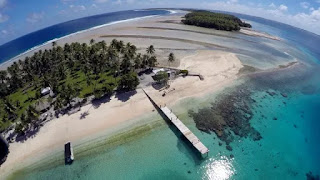Low-lying coral islands across the tropical oceans could become “uninhabitable” in the coming decades because of the combined impacts of sea level rise and large waves, a new study suggests.
Earlier research, based on sea level rise alone, suggested this wouldn’t happen until at least the end of this century.
But regular inundation from coastal flooding could push islands beyond a “tipping point” where groundwater resources cannot recover from infiltration by salty seawater, leaving residents with no drinkable water.
The study focuses on one atoll of the Marshall Islands, but the warning also applies to other populated atolls in the Pacific and Indian oceans, the researchers say – including those in the Cook Islands, Maldives, Seychelles, and Hawai’i.
However, the study may be giving an overly-pessimistic outlook, other scientists tell Carbon Brief. This is partly down to the sea level rise scenarios used, but also because many other atolls still support residents without usable groundwater.
Rising seas
For the world’s small island nations, the threat of rising seas looms large. Their long-term survival hinges on how effectively climate change is mitigated and sea level rise is curbed. It was no surprise, therefore, that small island states were determined to enshrine the 1.5C warming limit in the Paris Agreement.
But as the new Science Advances study explores, rising sea levels carry another menace – they allow high waves to reach further up – and potentially over – shorelines.
Read more at Low-Lying Atolls Could Become ‘Uninhabitable’ Earlier than Thought

No comments:
Post a Comment